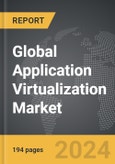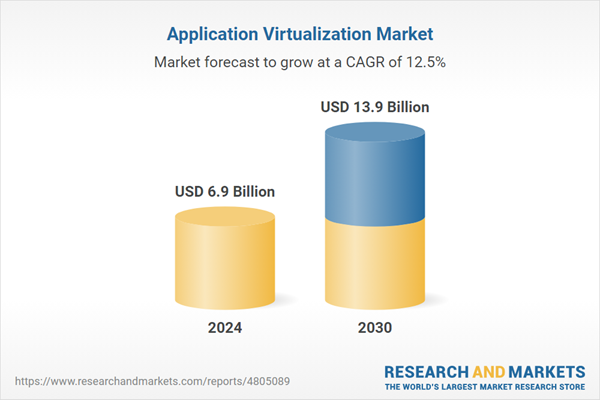The global market for Application Virtualization was valued at US$6.9 Billion in 2024 and is projected to reach US$13.9 Billion by 2030, growing at a CAGR of 12.5% from 2024 to 2030. This comprehensive report provides an in-depth analysis of market trends, drivers, and forecasts, helping you make informed business decisions. The report includes the most recent global tariff developments and how they impact the Application Virtualization market.
Segments: Component (Solutions, Services); Organization Size (Large Enterprises, SMEs); Vertical (BFSI, IT & Telecom, Healthcare, Government & Defense, Other Verticals).
Geographic Regions/Countries: World; United States; Canada; Japan; China; Europe (France; Germany; Italy; United Kingdom; and Rest of Europe); Asia-Pacific; Rest of World.
The analysts continuously track trade developments worldwide, drawing insights from leading global economists and over 200 industry and policy institutions, including think tanks, trade organizations, and national economic advisory bodies. This intelligence is integrated into forecasting models to provide timely, data-driven analysis of emerging risks and opportunities.
Global Application Virtualization Market - Key Trends and Drivers Summarized
Why Is Application Virtualization Becoming a Game-Changer in Modern IT Infrastructures?
In the rapidly evolving landscape of IT, application virtualization is emerging as a transformative technology that is reshaping how organizations deploy and manage software. Application virtualization allows applications to be delivered from a centralized server to a user's device without the need for direct installation on the local machine. This decoupling of applications from the underlying hardware enables greater flexibility, as software can be accessed on any device, anywhere, without compatibility issues. The rise of application virtualization is closely tied to the increasing demand for remote work capabilities, as it provides secure and seamless access to applications across diverse environments. Additionally, the technology significantly reduces the complexity of software management, as updates, patches, and configurations can be administered centrally, ensuring consistency across the organization. As businesses continue to prioritize agility and cost-efficiency, application virtualization is becoming an essential component of modern IT strategies, enabling companies to respond quickly to changing needs while minimizing operational overhead.How Are Technological Advancements Shaping the Future of Application Virtualization?
The future of application virtualization is being shaped by several key technological advancements that are expanding its capabilities and potential applications. The integration of artificial intelligence (AI) and automation into virtualization platforms is revolutionizing how applications are managed and optimized. AI-driven tools can predict resource requirements, automatically adjust performance settings, and even detect potential security threats, making virtualization smarter and more responsive. Additionally, the growing adoption of cloud computing is driving the development of cloud-native virtualization solutions, which offer scalability, flexibility, and ease of management. These cloud-based platforms allow businesses to deliver applications across multi-cloud environments, ensuring that users have consistent access regardless of their location or device. The shift towards containerization, where applications are packaged with all their dependencies into isolated containers, is also influencing virtualization strategies. Containers complement virtualization by providing lightweight, portable application environments that can be quickly deployed and scaled, further enhancing the efficiency and agility of IT operations. These technological trends are not only broadening the scope of application virtualization but also making it more integral to the digital transformation initiatives of enterprises.What Emerging Trends Are Driving the Adoption of Application Virtualization?
Several emerging trends are driving the growing adoption of application virtualization across industries. One of the most significant trends is the proliferation of bring-your-own-device (BYOD) policies, which allow employees to use their personal devices for work purposes. Application virtualization supports BYOD by ensuring that applications can be securely accessed on any device without compromising corporate data or user experience. The rise of hybrid and multi-cloud strategies is another key driver, as businesses seek solutions that can operate seamlessly across different cloud environments. Virtualization platforms that are designed to be cloud-agnostic are becoming increasingly popular, enabling organizations to leverage the benefits of multiple cloud providers without being locked into a single ecosystem. Additionally, the growing emphasis on business continuity and disaster recovery is propelling the adoption of application virtualization, as it allows for the rapid deployment and recovery of applications in the event of an outage or disaster. As enterprises continue to prioritize resilience and flexibility, these trends are making application virtualization a critical enabler of modern IT infrastructure.What Are the Key Factors Driving Growth in the Application Virtualization Market?
The growth in the application virtualization market is driven by several factors that reflect the evolving needs and priorities of businesses. Firstly, the widespread shift to remote work has created a strong demand for technologies that enable secure, remote access to applications, making virtualization an essential tool for ensuring business continuity and productivity. Secondly, the increasing complexity of IT environments, particularly with the adoption of multi-cloud and hybrid cloud strategies, is expanding the market for virtualization solutions that can simplify management and provide consistent performance across different platforms. Thirdly, the rise of cybersecurity concerns is driving demand for application virtualization as it enhances security by isolating applications from the underlying operating system, reducing the risk of malware and unauthorized access. Additionally, the trend towards containerization and microservices architecture is boosting the adoption of virtualization as it allows for more efficient resource utilization and faster deployment of applications. Finally, the growing focus on reducing IT costs and improving operational efficiency is encouraging organizations to invest in virtualization technologies that can streamline software management and reduce hardware dependencies. These factors, combined with ongoing technological advancements, are propelling the rapid growth of the application virtualization market, positioning it as a key component of modern IT strategies.Report Scope
The report analyzes the Application Virtualization market, presented in terms of units. The analysis covers the key segments and geographic regions outlined below.Segments: Component (Solutions, Services); Organization Size (Large Enterprises, SMEs); Vertical (BFSI, IT & Telecom, Healthcare, Government & Defense, Other Verticals).
Geographic Regions/Countries: World; United States; Canada; Japan; China; Europe (France; Germany; Italy; United Kingdom; and Rest of Europe); Asia-Pacific; Rest of World.
Key Insights:
- Market Growth: Understand the significant growth trajectory of the Application Virtualization Solutions segment, which is expected to reach US$8.1 Billion by 2030 with a CAGR of a 12.2%. The Application Virtualization Services segment is also set to grow at 12.8% CAGR over the analysis period.
- Regional Analysis: Gain insights into the U.S. market, valued at $1.9 Billion in 2024, and China, forecasted to grow at an impressive 11.9% CAGR to reach $2.1 Billion by 2030. Discover growth trends in other key regions, including Japan, Canada, Germany, and the Asia-Pacific.
Why You Should Buy This Report:
- Detailed Market Analysis: Access a thorough analysis of the Global Application Virtualization Market, covering all major geographic regions and market segments.
- Competitive Insights: Get an overview of the competitive landscape, including the market presence of major players across different geographies.
- Future Trends and Drivers: Understand the key trends and drivers shaping the future of the Global Application Virtualization Market.
- Actionable Insights: Benefit from actionable insights that can help you identify new revenue opportunities and make strategic business decisions.
Key Questions Answered:
- How is the Global Application Virtualization Market expected to evolve by 2030?
- What are the main drivers and restraints affecting the market?
- Which market segments will grow the most over the forecast period?
- How will market shares for different regions and segments change by 2030?
- Who are the leading players in the market, and what are their prospects?
Report Features:
- Comprehensive Market Data: Independent analysis of annual sales and market forecasts in US$ Million from 2024 to 2030.
- In-Depth Regional Analysis: Detailed insights into key markets, including the U.S., China, Japan, Canada, Europe, Asia-Pacific, Latin America, Middle East, and Africa.
- Company Profiles: Coverage of players such as Citrix Systems, Inc., Dell EMC, Google LLC, Microsoft Corporation, Ncomputing and more.
- Complimentary Updates: Receive free report updates for one year to keep you informed of the latest market developments.
Some of the 42 companies featured in this Application Virtualization market report include:
- Citrix Systems, Inc.
- Dell EMC
- Google LLC
- Microsoft Corporation
- Ncomputing
- Oracle Corporation
- Red Hat, Inc.
- SAP SE
- Symantec Corporation
- VMware, Inc.
Tariff Impact Analysis: Key Insights for 2025
Global tariff negotiations across 180+ countries are reshaping supply chains, costs, and competitiveness. This report reflects the latest developments as of April 2025 and incorporates forward-looking insights into the market outlook.The analysts continuously track trade developments worldwide, drawing insights from leading global economists and over 200 industry and policy institutions, including think tanks, trade organizations, and national economic advisory bodies. This intelligence is integrated into forecasting models to provide timely, data-driven analysis of emerging risks and opportunities.
What’s Included in This Edition:
- Tariff-adjusted market forecasts by region and segment
- Analysis of cost and supply chain implications by sourcing and trade exposure
- Strategic insights into geographic shifts
Buyers receive a free July 2025 update with:
- Finalized tariff impacts and new trade agreement effects
- Updated projections reflecting global sourcing and cost shifts
- Expanded country-specific coverage across the industry
Table of Contents
I. METHODOLOGYII. EXECUTIVE SUMMARY2. FOCUS ON SELECT PLAYERSIII. MARKET ANALYSISCANADAITALYREST OF EUROPEREST OF WORLDIV. COMPETITION
1. MARKET OVERVIEW
3. MARKET TRENDS & DRIVERS
4. GLOBAL MARKET PERSPECTIVE
UNITED STATES
JAPAN
CHINA
EUROPE
FRANCE
GERMANY
UNITED KINGDOM
ASIA-PACIFIC
Companies Mentioned (Partial List)
A selection of companies mentioned in this report includes, but is not limited to:
- Citrix Systems, Inc.
- Dell EMC
- Google LLC
- Microsoft Corporation
- Ncomputing
- Oracle Corporation
- Red Hat, Inc.
- SAP SE
- Symantec Corporation
- VMware, Inc.
Table Information
| Report Attribute | Details |
|---|---|
| No. of Pages | 194 |
| Published | April 2025 |
| Forecast Period | 2024 - 2030 |
| Estimated Market Value ( USD | $ 6.9 Billion |
| Forecasted Market Value ( USD | $ 13.9 Billion |
| Compound Annual Growth Rate | 12.5% |
| Regions Covered | Global |









